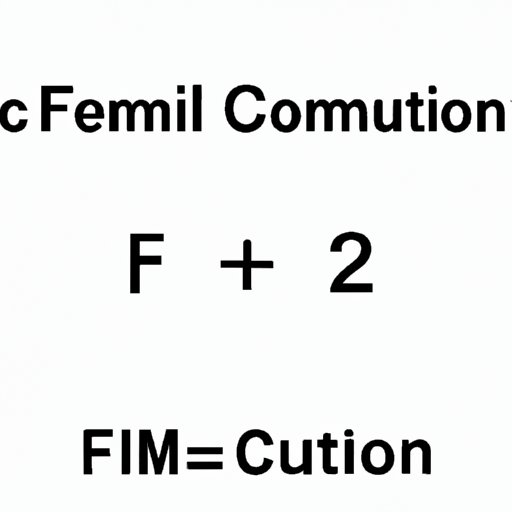Introduction
When dealing with numbers, it is important to understand how they relate to one another. One of the most essential concepts in number theory is the Greatest Common Factor (GCF). Simply put, the GCF is the largest number that divides two or more integers without leaving any remainder. Knowing how to find the GCF is an important skill as it is used in various mathematical applications, such as simplifying fractions, factoring polynomials, and solving word problems.
The Simplest Method to Find the GCF: Learn the Prime Factorization Technique
The prime factorization technique is widely considered as the simplest and most straightforward method to find the GCF of two or more numbers. Prime factorization is the process of finding the prime numbers that multiply together to form a given number.
To use prime factorization to find the GCF of two or more numbers, follow these steps:
- Find the prime factorization of each number
- Identify the common prime factors of the numbers
- Multiply the common prime factors to get the GCF
For example, let’s say we need to find the GCF of 24 and 36:
- The prime factorization of 24 is 2 x 2 x 2 x 3
- The prime factorization of 36 is 2 x 2 x 3 x 3
- The common prime factors are 2 x 2 x 3 = 12. Therefore, the GCF of 24 and 36 is 12.
Step-by-Step Guide: How to Calculate the Greatest Common Factor of Two Numbers
Another simple method to find the GCF of two numbers is to follow this step-by-step process:
- List all the factors of both numbers
- Identify the common factors of the numbers
- Choose the largest common factor to be the GCF
For example, let’s consider the numbers 20 and 30:
- The factors of 20 are 1, 2, 4, 5, 10, and 20
- The factors of 30 are 1, 2, 3, 5, 6, 10, 15, and 30
- The common factors are 1, 2, 5, and 10. Among these, the largest factor is 10. Therefore, the GCF of 20 and 30 is 10.
Tips and Tricks to Finding GCF: Utilizing Division and Multiplication
Division and multiplication can also be utilized to find the GCF of two or more numbers. Here are some methods:
- Division: Divide the larger number by the smaller number, then divide the smaller number by the remainder. Repeat this process until the remainder is 0. The last divisor is the GCF.
- Multiplication: Multiply the numbers together, then find the prime factors of the product. The common prime factors of the numbers will be the GCF.
For example, let’s say we need to find the GCF of 24 and 36 using the division method:
- 36 ÷ 24 = 1 with a remainder of 12
- 24 ÷ 12 = 2 with a remainder of 0
- The last divisor is 12. Therefore, the GCF of 24 and 36 is 12.
The Euclidean Algorithm: A Fool-Proof Way to Determine the GCF of Two or More Numbers
The Euclidean algorithm is a tried-and-true method for finding the GCF of two or more numbers. By repeatedly subtracting the smaller number from the larger number, the algorithm reduces the problem into finding the GCF of two smaller numbers.
To use the Euclidean algorithm to find the GCF of two or more numbers, follow these steps:
- List the numbers to be tested
- Find the remainder of dividing the larger number by the smaller number
- If the remainder is 0, the GCF is the smaller number
- If the remainder is not 0, repeat steps 2-4 with the smaller number and the remainder
For example, let’s say we need to find the GCF of 60 and 96 using the Euclidean algorithm:
- 60 and 96
- 96 ÷ 60 = 1 with a remainder of 36
- 60 ÷ 36 = 1 with a remainder of 24
- 36 ÷ 24 = 1 with a remainder of 12
- 24 ÷ 12 = 2 with a remainder of 0
- The last remainder is 12. Therefore, the GCF of 60 and 96 is 12.
Discover the GCF of Two Numbers Using a Venn Diagram
A Venn diagram is a graphical representation that is often used in mathematics to show the relationships between sets and subsets. It can also be used to find the GCF of two numbers by representing the factors of each number in separate circles and identifying the common factors in the region where the circles overlap.
For example, let’s say we need to find the GCF of 24 and 36 using a Venn diagram:

As shown in the diagram, the common factors are 2 and 3. Therefore, the GCF of 24 and 36 is 2 x 3 = 6.
Shortcuts and Techniques to Find the GCF: Helpful Strategies for Successful Math Students
Here are some general tips and shortcuts that can be used to find the GCF of two or more numbers quickly and efficiently:
- Breaking down the numbers: If one or both of the numbers are even, divide both numbers by 2 until there are no more even numbers. This simplifies the problem and makes finding the GCF easier.
- Skip-counting: For smaller numbers, skip-counting can be a useful technique. Take the smallest number and count up by it until you find a factor of the larger number. Repeat this process until you find the largest factor that both numbers share.
Conclusion
Knowing how to find the GCF of two or more numbers is an essential skill for any student of mathematics. There are various methods to find the GCF, including prime factorization, division and multiplication, the Euclidean algorithm, Venn diagrams, and shortcuts. By practicing and experimenting with different techniques, students can become more confident in their ability to solve GCF problems and apply this knowledge to various mathematical applications.
